Metropolitan Police Service
| Metropolitan Police Service | |
|---|---|
|
Logo | |
 Flag | |
| Common name | The Met[1] |
| Abbreviation | MPS[2] |
| Motto | Total Policing[1] |
| Agency overview | |
| Formed | 29 September 1829[3] |
| Preceding agencies | |
| Employees |
43,000+ in total[6] 31,075 police officers[6] 8,732 police staff[6] 1,464 PCSOs[6] |
| Volunteers |
2,763 special constables 1,500 Met Police volunteers 3,658 volunteer police cadets |
| Annual budget | £3.24 billion[7] |
| Legal personality | Police force |
| Jurisdictional structure | |
| Operations jurisdiction | Metropolitan Police District, Greater London, UK |
.svg.png) | |
| Map of police area | |
| Size | 1,578 km2 (609 sq mi) |
| Population | more than 8 million[8] |
| Legal jurisdiction |
England and Wales (throughout the whole of the United Kingdom, including Scotland and Northern Ireland, under certain limited circumstances) |
| Primary governing body | Mayor's Office for Policing and Crime |
| Secondary governing body | Home Office |
| Constituting instruments | |
| General nature | • Local civilian agency |
| Operational structure | |
| Overviewed by | Home Office/HMIC/IPCC |
| Headquarters | New Scotland Yard |
|
| |
| Police officers |
31,075 full time 2,763 special constables |
| PCSOs | 1,464 |
| Deputy Mayor for Policing and Crime responsible | |
| Agency executives | |
| Facilities | |
| Stations | 180 |
| Boats | 22 |
| Dogs | 250 |
| Website | |
| www.met.police.uk | |
The Metropolitan Police Service (MPS), commonly known as the Metropolitan Police and informally as the Met, is the territorial police force responsible for law enforcement in Greater London, excluding the "square mile" of the City of London, which is policed by the much smaller City of London Police.
The Met also has significant national responsibilities, such as co-ordinating and leading on UK-wide national counter-terrorism matters and protecting the Royal Family, certain members of Her Majesty's Government and others as deemed appropriate.[9] As the police force for the capital, the Met has significant unique responsibilities and challenges within its police area, such as protecting 164 foreign embassises and High Commissions[10], policing Heathrow Airport (the busiest airport in Europe), policing and protecting the Palace of Westminster, and dealing with significantly more protests and events than any other force in the country (3,500 such events in 2016).[10]
As of September 2017, the Met had 40,874 full-time personnel. This included 30,871 police officers, 8,005 police staff, 1,384 police community support officers and 614 designated officers.[11] This number excludes the 2,470 special constables, who work voluntarily part-time (a minimum of 16 hours a month) and who have the same powers and uniform as their regular colleagues. This makes the Metropolitan Police, in terms of officer numbers, the largest police force in the United Kingdom by a significant margin, and one of the biggest in the world.[12] In terms of its police area (primary geographic area of responsibility), leaving its national responsibilities aside, the Met has the 8th smallest police area of the territorial police forces in the United Kingdom.
The overall operational leader of the force is the Commissioner, whose formal title is Commissioner of Police of the Metropolis. The Commissioner is answerable, responsible and accountable to The Queen, the Home Office and the Mayor of London, through the Mayor's Office for Policing and Crime. The post of Commissioner was first held jointly by Sir Charles Rowan and Sir Richard Mayne. Cressida Dick is the current Commisioner having been been appointed in April 2017.
A number of informal names and abbreviations are applied to the Metropolitan Police Service, the most common being the Met. In colloquial London (or Cockney slang), it is sometimes referred to as the Old Bill.[13] The Met is also referred to as Scotland Yard after the location of its original headquarters in a road called Great Scotland Yard in Whitehall.[14] The Met's current headquarters is New Scotland Yard, situated on the Victoria Embankment.
History
The Metropolitan Police Service, whose officers became affectionately known as "bobbies", was founded in 1829 by Robert Peel under the Metropolitan Police Act 1829 and on 29 September of that year, the first units of the service appeared on the streets of London.[15] In 1839, the Marine Police Force, which had been formed in 1798, was amalgamated into the Metropolitan Police.[16] In 1837, it also incorporated with the Bow Street Horse Patrol that had been organised in 1805.[17]
Governance
Since January 2012, the Mayor of London is responsible for the governance of the Metropolitan Police through the Mayor's Office for Policing and Crime (MOPAC). The mayor is able to appoint someone to act on his behalf; the current office-holder is Deputy Mayor for Policing and Crime, Sophie Linden. The work of MOPAC is scrutinised by the Police and Crime Committee (also known as a police and crime panel) of the London Assembly. These structures were created by the Police Reform and Social Responsibility Act 2011 and replaced the Metropolitan Police Authority appointed board created in 2000 by Greater London Authority Act 1999.
Police area and other forces

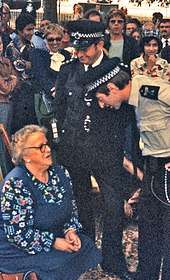
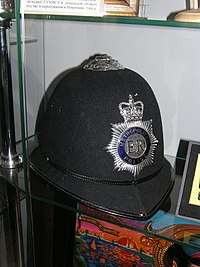
The area policed by the Metropolitan Police Service is known as the Metropolitan Police District (MPD). In terms of geographic policing, the Met was divided into a number of 32 Borough Operational Command Units, which directly align with the 32 London boroughs covered. Since 2017 this situation has changed as the Met has attempted to save money due to cuts in funding. There is currently a period of transition which will result in the MPD being divided into 12 Basic Command Units made up of two or three boroughs. There is criticism of these changes.[18] The City of London (which is not a London borough) is a separate police area and is the responsibility of the separate City of London Police.
The Ministry of Defence Police are responsible for policing of Ministry of Defence property throughout the United Kingdom, including its headquarters in Whitehall and other MoD establishments across the MPD.[19]
The British Transport Police are responsible for policing of the rail network in the United Kingdom, including London. Within London, they are also responsible for the policing of the London Underground, Tramlink, The Emirates Air Line (cable car) and the Docklands Light Railway.[20]
The English part of the Royal Parks Constabulary, which patrolled a number of Greater London's major parks, was merged with the Metropolitan Police in 2004, and those parks are now policed by the Royal Parks Operational Command Unit.[21] There is also a small park police force, the Kew Constabulary, responsible for the Royal Botanic Gardens, whose officers have full police powers within the park. A few London borough councils maintain their own borough park constabularies, though their remit only extends to park by-laws, and although they are sworn as constables under laws applicable to parks, their powers are not equal to those of constables appointed under the Police Acts, meaning that they are not police officers.[22]
Metropolitan Police officers have legal jurisdiction throughout all of England and Wales, including areas that have their own special police forces, such as the Ministry of Defence, as do all police officers of territorial police forces.[23] Officers also have limited powers in Scotland and Northern Ireland.[24] Within the MPD, the Met will take over the investigation of any serious crime from the British Transport Police and Ministry of Defence Police, if it is deemed appropriate. Terrorist incidents and complex murder enquiries will almost always be investigated by the Met,[25][26] with the assistance of any relevant specialist force, even if they are committed on railway or Ministry of Defence property. A minor oddity to the normal jurisdiction of territorial police officers in England and Wales is that Met officers involved in the protection duties of the Royal Family and other VIPs have full police powers in Scotland and Northern Ireland in connection with those duties.[27]
Organisation and structure
The Metropolitan Police Service is organised into the following directorates:[29]
- Frontline Policing
- Met Operations
- Specialist Operations
- Directorate of Professionalism
- Shared Support Services (part of Met Headquarters)
Each is overseen by an Assistant Commissioner, or in the case of administrative departments, a director of police staff, which is the equivalent civilian staff grade. The management board is made up of the Commissioner, Deputy Commissioner, Assistant Commissioners and Directors.
Ranks
The Metropolitan Police Service uses the standard British police ranks, indicated by shoulder boards, up to Chief Superintendent, but uniquely has five ranks above that level instead of the standard three; namely Commander, Deputy Assistant Commissioner, Assistant Commissioner, Deputy Commissioner and Commissioner.[30] All senior officers of the rank of Commander and above are chief police officers of NPCC (previously ACPO) rank.
The Met approved the use of name badges in October 2003, with new recruits wearing the Velcro badges from September 2004. The badge consists of the wearer's rank, followed by their surname.[31]
Following controversy over assaults by uniformed officers with concealed shoulder identification numbers[32] during the G20 summit, Commissioner Sir Paul Stephenson said, "the public has a right to be able to identify any uniformed officer whilst performing their duty" by their shoulder identification numbers.[33]
The Met uniformed officer rank structure, with shoulder badge features, is as follows:
- Police Constable (PC): Divisional call sign and shoulder number. Note that Detective Constables and Police Constables are the same rank.
- Sergeant (Sgt or PS): Three pointing-down chevrons above the divisional call sign and shoulder number. An "acting" sergeant, such as a substantive constable being paid an allowance to undertake the duties of a sergeant for a short period of time, displays two pointing-down chevrons above the divisional call sign, and shoulder number. The use of three chevrons by an acting sergeant is technically incorrect. Three chevrons should only be used during a period of temporary (as opposed to acting) promotion or when substantively in the rank.
- Inspector (Insp): Two Order of the Bath stars, informally known as "pips".
- Chief Inspector (C/Insp): Three pips.
- Superintendent (Supt): Single crown.
- Chief Superintendent (C/Supt): Single crown over one pip.
- Commander (Cmdr): Crossed tipstaves in a bayleaf wreath. This is the first ACPO rank.
- Deputy Assistant Commissioner (DAC): One pip over Commander's badge.
- Assistant Commissioner (Asst Comm): Crown over Commander's badge.
- Deputy Commissioner (D/Comm): Crown above two side-by-side small pips, above Commander's badge.
- Commissioner (Comm): Crown above one pip above Commander's badge.
| Police Constable | Sergeant | Inspector | Chief Inspector | Superintendent | Chief Superintendent | Commander | Deputy Assistant Commissioner | Assistant Commissioner | Deputy Commissioner | Commissioner |
|---|---|---|---|---|---|---|---|---|---|---|
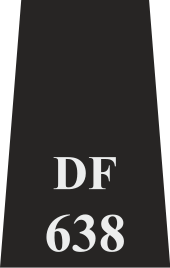 |  | 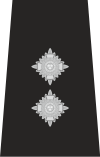 | 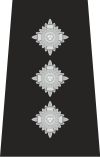 |  | 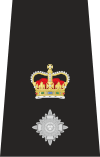 | 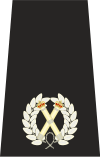 | 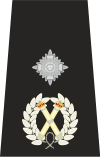 |  | 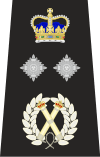 | 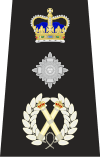 |
| ||||||||||
The Met also has several active Volunteer Police Cadet units, which maintain their own internal rank structure.[34] The Metropolitan Special Constabulary (MSC) is a contingent of part-time volunteer police officers and is attached to most Borough Operational Command Units. The MSC has its own internal rank structure.
The prefix "Woman" in front of female officers' ranks has been obsolete since 1999. Members of the Criminal Investigation Department (CID) up to and including the rank of Chief Superintendent prefix their ranks with "Detective". Detective ranks are equivalent in rank to their uniform counterparts. Other departments, such as Special Branch and Child Protection, award non-detectives "Branch Detective" status, allowing them to use the "Detective" prefix. None of these detective ranks confer on the holder any extra pay or supervisory authority compared to their uniformed colleagues.
Resources
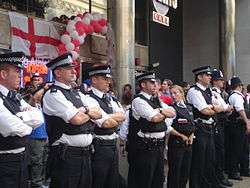
.jpg)
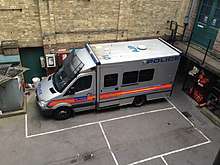
The Metropolitan Police Service consists of regular police officers and volunteer part time special constables (both of whom have full police powers), and employed civilian staff and police community support officers.[35] The Met was the first force to introduce PCSOs. Unlike police staff and PCSOs, police officers are not employees: they are servants of the crown.
Police numbers
Historic numbers of police officers
- 2017: 30,817 [11]
- 2016: 32,125 [38]
- 2015: 31,877 [38]
- 2014: 30,932 (excluding 4,587 Special Constables)[39]
- 2013: 30,398 (excluding 5,303 Special Constables)[40]
- 2011: 32,380 (excluding 4,459 Special Constables)[41]
- 2010: 33,260 (excluding 3,125 Special Constables)[42]
- 2009: 32,543 (excluding 2,622 Special Constables)[43]
- 2004: 31,000 (approx)[44]
- 2003: 28,000 (approx)[44]
- 2001: 25,000 (approx)[45]
- 1984: 27,000 (approx)[46]
- 1965: 18,016[47]
- 1952: 16,400[48]
- 1912: 20,529[49]
- 1887: 14,191[50]
- 1852: 5,625[51]
Fleet
The Met operates and maintains a fleet of more than 8,000 vehicles,[52] which are used for a range of duties, including:[53]
- Area Cars: used for patrol and 999 emergency response and are driven by advanced drivers.
- Incident Response Vehicles (IRV) or Response Cars: used for patrol and 999 emergency response.

- Armed Response Vehicle (ARV): Transports Authorised firearms officers, SFOs and CTSFOs to incidents involving firearms

- Traffic Units : used to patrol the motorways and are pursuit authorized, enforce traffic laws and encourage road safety.
- Protected Carriers: used for public order duties.
- Control Units: used for incident command and control purposes.
- Armoured Multi-role Vehicles: used for public order duties, airport duties or as required. Staffed by CTSFOs.
- General Purpose Vehicles: used for general support and transportation duties of officers or equipment.
- Training Vehicles: used to train police drivers under lights and sirens.
- Miscellaneous Vehicles: such as horseboxes and trailers.
The majority of vehicles have a service life of three to five years; the Met replaces or upgrades between 800 and 1,000 vehicles each year. As of 2012, the Met has transitioned all new vehicles into the Battenburg markings, which is a highly-reflective material on the side of the vehicles, chequered blue and yellow (symbol of police). The old livery was an orange stripe through the vehicle, with the force's logo. However, these liveries are becoming hard to find, as all new vehicles are being fitted with Battenburg.
The National Police Air Service has a base at Lippitts Hill, in Essex, which houses three helicopters to support surrounding forces, including the Met.
A marine policing unit operates 22 vessels from its base in Wapping.
.jpg)
Budget
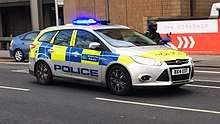
Annual expenditure for single years, selected by quarter centuries.[54]
- 1829/30: £194,126
- 1848: £437,441
- 1873: £1.1M
- 1898: £1.8M
- 1923: £7.8M
- 1948: £12.6M
- 1973: £95M
- 1998/9: £2.033bn
- 2011/12: £3.692bn
- 2017/18: £3.269bn[55]
Crime figures
Crimes reported within the Metropolitan Police District, selected by quarter centuries.[58]
- 1829/30: 20,000
- 1848: 15,000
- 1873: 20,000
- 1898: 18,838
- 1923: 15,383
- 1948: 126,597
- 1973: 355,258
- 1998/9: 934,254
- 2017/18: 827,225[59]
Detection rates
The following table shows the percentage detection rates for the Metropolitan Police by offence group for 2010/11.[60]
| Total | Violence against the person | Sexual offences | Robbery | Burglary | Offences against vehicles | Other theft offences | Fraud and forgery | Criminal damage | Drug offences | Other offences | |
|---|---|---|---|---|---|---|---|---|---|---|---|
| Metropolitan Police | 24 | 35 | 23 | 17 | 11 | 5 | 14 | 16 | 13 | 91 | 63 |
| England and Wales | 28 | 44 | 30 | 21 | 13 | 11 | 22 | 24 | 14 | 94 | 69 |
The Metropolitan Police Service “screened out” 34,164 crimes the day they were reported in 2017 and did not investigate them further. This compares to 13,019 the previous year. 18,093 crimes were closed in 24 hours during the first 5 months of 2018 making it likely that the 2017 total will be exceeded. Crimes not being investigated include sexual assaults and arson, burglaries, thefts and assaults. Critics maintain this shows the effect of austerity on the force’s ability to carry out its responsibilities.[61]
Specialist units
- Diplomatic Protection Group – Provides personal armed protection for the Royal family, Prime Minister and other ministers, ambassadors and visiting heads of state. Special Operation units SO1 and SO14 merged in April 2015, to form RaSP (Royalty and Specialist Protection) which provides the roles above. The Diplomatic Protection Group (DPG) is responsible for providing armed officers that guard important residences such as Downing Street, but not Buckingham Palace and other palaces, as RaSP provides this.[62] The Special Escort Group (SEG) are responsible for escorting the Royal Family, Prime Minister and other ministers, ambassadors and visiting heads of state, and occasionally prisoner transport. They use motorcyclists to halt traffic, and use armed cars at the rear of the escort for armed assistance and traffic control. Once the escort has passed, the roads are immediately opened, different to how the United States handle police escorts, which tend to close the road off completely. All SEG officers are armed, the motorcycle officers carrying the Glock 17, and the car officers which utilize the more effective firearms such as the G36 and MP5 semi-automatic carbines.Their motto is "We lead, others follow".
- Aviation Policing – Responsible for providing armed support and policing at Heathrow Airport and London City Airport.[63]
- Flying Squad – A unit which investigates and intercepts robberies. The name comes from the fact its members travelled across divisional and borough boundaries.
- Trident Gang Crime Command – Investigates and works to prevent gang crime.
- Roads and Transport Policing Command – Provides policing for the transport network in London. However, the main division, the Traffic Division, patrols the roads, capable of securing Road Traffic Collisions (RTC), pursuing fleeing suspects and enforcing speed, safety, and drink driving.[64]
- Specialist Firearms Command – (SCO19) Responsible for providing armed response and support across the whole of London with 3 Authorised Firearms Officers (AFO) travelling in ARVs (Armed Response Vehicles) responding to calls involving firearms and weapons, which may put a unarmed officers at risk. SCO19 has a small number of CTSFOs (Counter Terrorist Specialist Firearms Officers), who have a higher level of training.[65]
- Dog Support Unit – (DSU) Provides highly trained dogs and police handlers. They are trained to detect drugs and firearms, respond to searches, missing people, and fleeing suspects. There is also a division which has bomb-detection dogs.[66]
- Marine Policing Unit – (MPU) Provides policing on the waterways of London, responding to situations in the River Thames and tracking and stopping illegal vessels entering and exiting London.[67]
- Mounted Branch – Provides policing on horseback in London. One of their duties is escorting the Royal Guard down The Mall, into and out of Buckingham Palace every morning from April to July, then occasionally through the remainder of the year. They also provide public order support and are commonly called to police football matches in the event of any unrest. All officers are trained in public order tactics on horseback.[68]
- Territorial Support Group – (TSG) Highly trained officers, specialised in public order and large scale riots responding around London in marked Public Order Vehicles (POV) with 6 constables and a sergeant in each POV. They aim to: secure the capital against terrorism, respond to any disorder in London, and reduce priority crime through borough support. They respond in highly-protective uniform during riots or large disorder, protecting themselves from any thrown objects or hazards.[69]
- The Air Support Unit was formerly a division within MPS, operating 3 EC145 helicopters based at Lippitts Hill, Essex. In October 2015, this was absorbed into the National Police Air Service - responsible for the operation of all police aviation in England and Wales. The staff previously based at the ASU are on full-time secondment to NPAS, still operating with the same helicopters and from the same base.
Vehicles
All vehicles listed are vehicles used by the Metropolitan Police at this current time.
Incident Response Vehicles (IRV) or also known as Response Cars:
- Ford Focus Estate
- Hyundai i30
- Vauxhall Astra Estate
- Peugeot 308
- Ford Transit Custom
Area Cars (Pursuit authorised):
Roads Policing Units (RPU) or also known as Traffic Units (Pursuit authorised):
Armed Response Vehicles (ARV):
Public Order Vehicles (POV):
Dog Support Units (DSU):
Prisoner Transport Units (PTU) and Officer Carriers:
Special Escort Group (SEG):
Miscellaneous Vehicles:
- Ford Super Duty (Modified/Armoured) 'Jankel' - Armed Airport Duties/Riot Control (Armoured Vehicle)
- Renault Midlum - Vehicle Recovery & Examination
- Vauxhall Movano - Commercial Vehicle Unit
- Mercedes-Benz Actros - Cycle Safety Unit
- Land Rover Discovery - Ordnance Disposal Team
- Iveco Stralis - Police Horse Box
- Vauxhall Combo - Forensic Services
Stations
In addition to the headquarters at New Scotland Yard, there are many police stations in London.[70] These range from large borough headquarters staffed around the clock every day to smaller stations, which may be open to the public only during normal business hours, or on certain days of the week. In 2017, there were 73 working front counters open to the public in London.[71]
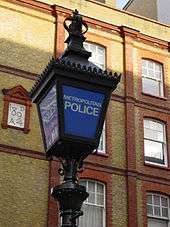
Most police stations can easily be identified from one or more blue lamps located outside the entrance, which were introduced in 1861.
The oldest Metropolitan police station, which opened in Bow Street in 1881, closed in 1992 and the adjoining Bow Street Magistrates' Court heard its last case on 14 July 2006.[72] The oldest operational police station in London is in Wapping, which opened in 1908. It is the headquarters of the marine policing unit (formerly known as Thames Division), which is responsible for policing the River Thames. It also houses a mortuary and the River Police Museum.
Paddington Green Police Station, which is no longer operational, received much publicity for its housing of terrorism suspects in an underground complex prior to its closure in 2017.
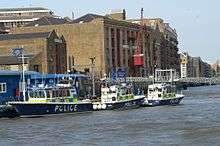
In 2004, there was a call from the Institute for Public Policy Research for more imaginative planning of police stations to aid in improving relations between police forces and the wider community.[73]
Officers killed in the line of duty
The Police Memorial Trust lists and commemorates all British police officers killed in the line of duty, and since its establishment in 1984 has erected dozens of memorials to some of those officers.
See also
- 999 (emergency telephone number)
- Aerial roof markings
- Crimint
- Cybercrime
- Hendon Police College
- London Emergency Services Liaison Panel
- Metropolitan police role in phone hacking scandal
- New Scotland Yard
- News International phone hacking scandal
- Police Forces of the United Kingdom
- Police National E-Crime Unit
- Project Griffin
- Regal, Olga, and Upstart, three MPS horses decorated for bravery during the Blitz
- Royal National Lifeboat Institution
- Scotland Yard
- Super recognisers
- Bent Coppers, detailing police corruption within the Metropolitan Police Service
- The Met: Policing London
Other London emergency services:
References
- 1 2 "Metropolitan Police Service – Homepage". Metropolitan Police. 2 April 2009. Retrieved 6 May 2009.
- ↑ "Contacts: MPS". MPA. Archived from the original on 14 January 2012. Retrieved 2 June 2010.
- ↑ "Metropolitan Police Service – History of the Metropolitan Police Service". Metropolitan Police. Archived from the original on 26 April 2009. Retrieved 6 May 2009.
- ↑ "The Bow street runners – Victorian Policeman by Simon Dell OBE QCB – Devon & Cornwall Constabulary". Devon-cornwall.police.uk. Archived from the original on 13 October 2003. Retrieved 6 May 2009.
- ↑ "Policing the Port of London – Crime and punishment". Port Cities. Archived from the original on 5 October 2012. Retrieved 6 May 2009.
- 1 2 3 4 "The structure | the Met". www.met.police.uk. Retrieved 2018-03-07.
- ↑ "Archived copy" (PDF). Archived from the original (PDF) on 20 December 2016. Retrieved 11 December 2016.
- ↑ "About the Met Police: Jurisdiction". Retrieved 11 October 2017.
- ↑ "MPA — Metropolitan Police dedicated to protecting the UK from terrorism". whitehallpages.net. Archived from the original on 24 July 2011. Retrieved 22 July 2011.
- 1 2 "MPS Business Plan 2017-18" (PDF). Retrieved 6 October 2018.
- 1 2 3 4 5 6 7 "Police workforce, England and Wales: 30 September 2017". GOV.UK. Retrieved 2018-05-29.
- ↑ "Metropolitan Police Authority". MPA. Archived from the original on 19 July 2006. Retrieved 20 July 2006.
- ↑ "Origins of the name "Old Bill"". Metropolitan Police. 2009. Archived from the original on 6 April 2014. Retrieved 27 May 2011.
- ↑ Douglas Browne (1956) The Rise of Scotland Yard: A History of the Metropolitan Police
- ↑ "September 29: On This Day in History". OnThisDay.com. Retrieved 2017-09-28.
- ↑ "Thames Police - History Page". www.thamespolicemuseum.org.uk.
- ↑ Archived 25 September 2006 at the Wayback Machine.
- ↑ "Met to merge all policing boroughs". BBC News. 2018-02-12. Retrieved 2018-10-06.
- ↑ "Ministry of Defence Police". MOD. Retrieved 28 December 2008.
- ↑ About us. Btp.police.uk. Retrieved on 2013-12-06.
- ↑ "Policing the Royal Parks – keeping you safe in the Royal Parks". Royalparks.org.uk. 1 April 2004. Archived from the original on 19 February 2009. Retrieved 6 May 2009.
- ↑ The Committee Office, House of Lords. "House of Lords – Unopposed Bill Committee – Minutes of Evidence". Parliament of the United Kingdom. Retrieved 6 May 2009.
- ↑ "Police Act 1996". www.legislation.gov.uk.
- ↑ "Criminal Justice and Public Order Act 1994". www.legislation.gov.uk.
- ↑ "A protocol between police forces and the Ministry of Defence police - Home Office". webarchive.nationalarchives.gov.uk. Archived from the original on 25 January 2013.
- ↑ "Archived copy" (PDF). Archived from the original (PDF) on 12 March 2017. Retrieved 10 March 2017.
- ↑ "Police Act 1996". www.legislation.gov.uk.
- ↑ "Home - The Met". content.met.police.uk. Retrieved September 30, 2018.
- ↑ "Home - The Met". content.met.police.uk. Retrieved September 30, 2018.
- ↑ "Badges of Rank". Metropolitan Police Service. Archived from the original on 18 July 2006. Retrieved 19 July 2006.
- ↑ Clerk and Treasurer (20 October 2003). "Report 4 of the 20 Oct 03 meeting of the Co-ordination and Policing Committee: Introduction of name badges". Metropolitan Police Authority. Archived from the original on 20 February 2012. Retrieved 3 June 2014.
- ↑ "Met suspends G20 footage officer". BBC News. 15 April 2009. Retrieved 6 May 2009.
- ↑ "Police begin G20 tactics review". BBC News. 16 April 2009. Retrieved 6 May 2009.
- ↑ "Volunteer Police Cadets". Metropolitan Police Service. Retrieved 19 July 2006.
- ↑ "Metropolitan Police PCSO". Metropolitan Police. Archived from the original on 8 April 2010. Retrieved 2 June 2010.
- ↑ "Dog Support Unit - History". Metropolitan Police. Retrieved 4 June 2015.
- ↑ "Mounted Branch – Introduction". Metropolitan Police. Archived from the original on 11 July 2006. Retrieved 13 June 2010.
- 1 2 "Police Service Strength, House of Commons Library Briefing Paper 00634 23 March 2018: 23/03/18" (PDF). Retrieved 3 Oct 2018.
- ↑ "Police Workforce Data, 2014: 14/03/14". Retrieved 23 May 2015.
- ↑ "Police Workforce Data, 2013: 13/03/13". Retrieved 23 May 2015.
- ↑ "MPS Police officer, staff and PCSO numbers: 31/03/11". Archived from the original on 27 January 2012. Retrieved 7 January 2012.
- ↑ "MPS Police officer, staff and PCSO numbers: 31/03/10". Archived from the original on 14 August 2011. Retrieved 18 July 2011.
- ↑ "MPS Police officer, staff and PCSO numbers: 31/03/09". Archived from the original on 14 August 2011. Retrieved 18 July 2011.
- 1 2 GLA press release Archived 5 September 2006 at the Wayback Machine., 11 March 2003
- ↑ Hansard, 23 April 2001. London population at the time was 7,172,000.
- ↑ Hansard, 26 February 1996
- ↑ The Thin Blue Line, Police Council for Great Britain Staff Side Claim for Undermanning Supplements, 1965
- ↑ Report of the Commissioner of Police of the Metropolis for the Year 1952. Included 35 Chief Superintendents (including one woman), 12 Detective Chief Superintendents, 62 Superintendents (including one woman), 16 Detective Superintendents, 128 Chief Inspectors (including five women), 64 Detective Chief Inspectors (including one woman), 20 Station Inspectors, 465 Inspectors (including four women), 140 Detective Inspectors (including one woman), 441 Station Sergeants, 202 1st Class Detective Sergeants, 1,834 Sergeants (including 32 women), 414 2nd Class Detective Sergeants (including six women), 11,951 Constables (including 310 women), and 615 Detective Constables (including 27 women). The official establishment was 20,045.
- ↑ Raymond B. Fosdick, European Police Systems, 1915. Figures at 31 December 1912, including 33 Superintendents, 607 Chief Inspectors and Inspectors, 2,747 Sergeants and 17,142 Constables.
- ↑ "METROPOLITAN POLICE (NUMBERS). (Hansard, 2 March 1888)". api.parliament.uk. Retrieved 2018-05-29.
- ↑ Commons, Great Britain Parliament House of (1852). Accounts and Papers of the House of Commons. Ordered to be printed.
- ↑ "Fleet Manager". Retrieved 31 March 2011.
- ↑ "Microsoft Word - 2011010002376.doc" (PDF). Archived from the original (PDF) on 17 January 2012. Retrieved 22 July 2011.
- ↑ Fido, Martin; Keith Skinner (2000). Official Encyclopedia of Scotland Yard. Virgin. p. 56. ISBN 1-85227-712-2.
- ↑ https://www.london.gov.uk/about-us/london-assembly/london-assembly-publications/police-funding-whos-paying-bill
- ↑ Mayor's Office for Policing and Crime and Group. Statement of Accounts 2014/15. See the outturn column in the table on page vi.
- ↑ Mayor's Office for Policing and Crime. Statement of Accounts 2011/12 Archived 16 November 2012 at the Wayback Machine..
- ↑ Fido, Martin; Keith Skinner (2000). Official Encyclopedia of Scotland Yard. Virgin. p. 57. ISBN 1-85227-712-2.
- ↑ https://news.sky.com/story/knife-crime-rises-in-england-and-wales-as-london-murders-surge-11346934
- ↑ Home Office (July 2011). Crimes detected in England and Wales 2010/11 Archived 7 October 2011 at the Wayback Machine.. See Excel file for "Police force area tables".
- ↑ Met police dropped 30,000 criminal investigations in first 24 hours last year The Guardian
- ↑ "Home - The Met". content.met.police.uk.
- ↑ "Home - The Met". content.met.police.uk.
- ↑ "Home - The Met". content.met.police.uk.
- ↑ "Home - The Met". content.met.police.uk.
- ↑ "Home - The Met". content.met.police.uk.
- ↑ "Home - The Met". content.met.police.uk.
- ↑ "Home - The Met". content.met.police.uk.
- ↑ "Home - The Met". content.met.police.uk.
- ↑ "Met Police stations: A-Z Directory". Metropolitan Police. Archived from the original on 5 February 2009. Retrieved 8 June 2009.
- ↑ https://www.bbc.co.uk/news/uk-england-london-40607533
- ↑ "BBC: Bow Street court closes its doors". BBC News. 14 July 2006. Retrieved 8 June 2009.
- ↑ Institute for Public Policy Research: Re-inventing the police station Archived 27 September 2006 at the Wayback Machine. (PDF)
External links
| Wikimedia Commons has media related to Metropolitan Police Service. |